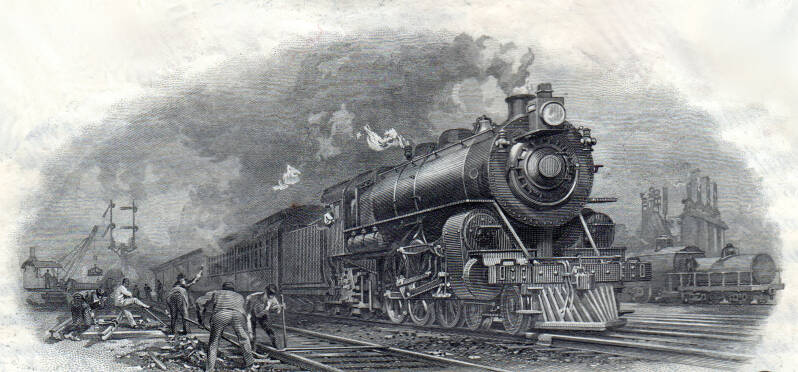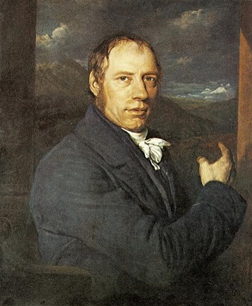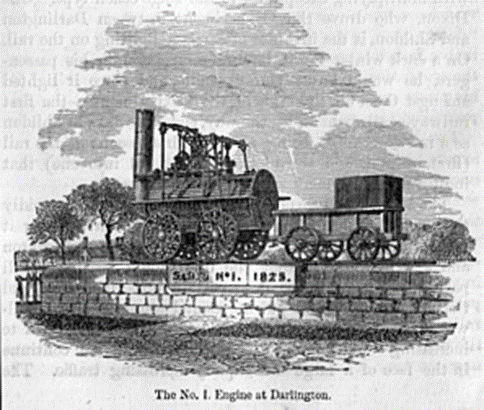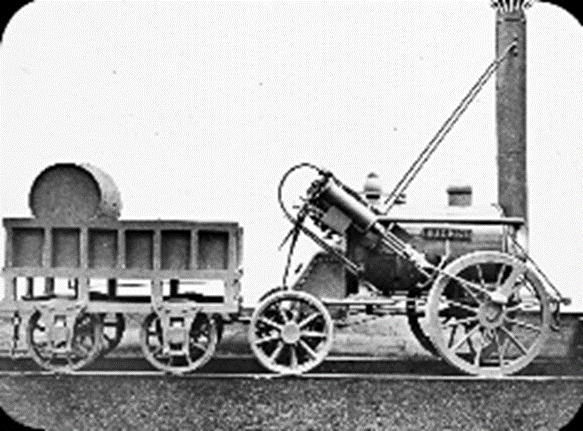History of the Railroad : Article 2

Invention of the Steam Locomotive
In the first article, we saw how the steam engine was developed and two other applications of use.
In this article, we will look at its first application in expanding into a steam locomotive.
Prior to the invention of the steam locomotive, there were different types of motive forces behind pulling a load on a tramway. They were of a lower technological design. The pay load was pulled along by horsepower, manpower, or by using a stationary engine prior to having the locomotive.
The word locomotive is an etymologies (not a definition, but explanations of what the word means and how they sounded 600 to 2,000 years ago). The two words are of the Latin word loco which means “from a place” and a Medieval Latin word motive “causing motion”.
The word locomotive was first used in 1814 that distinguishs between a self-propelled and a stationary engine.

Trevithick's Coalbrookdale locomotive
circa. 1829 author unknown,
Public domain, via Wikimedia Commons

The first steam propelled locomotive was invented by Richard Trevithick in 1804. Richard was a British mechanical engineer and inventor who had successfully harnessed high-pressure steam. The rest of the prominent engineers of the day thought it to be to dangerous to accomplish. Wonder why they were so skeptical?
A sealed metal container with steam being condensed is a recipe for an explosion. If even a pin hole develops, a smallest stream of high pressure steam acts as a light saber. The stream would be invisible, so if you were to walk through it, it would actually cut off your legs. In the Navy, when we had a suspected steam leak, the person who had to check for it would walk around the Main Space (Boiler Room), swinging a 2 by 4 in front of them. If a piece of 2x4 fell off, you would know you had found the leak.
Painting of Richard Trevithick,
the engineer, by John Linnell
John Linnell (1792-1882),
Public domain, via
Wi kimedia Commons
Through this, in 1802, Richard and his cousin Andrew Vivian took out a patent for a high-pressure steam engine, for stationary and locomotive use.
Then in 1803 he constructed the world's first steam railway locomotive. Building it at Samuel Hemfray’s Perdarren Ironworks in South Wales. To win a wager on February 21,1804 at Hemfray's Tydfil, he hauled a load of 10 tons of ore and seventy men for ten miles on a tramway. He had made it for the Coalbrookdale Ironworks in Shropshire in the United Kingdom.
Richard Trevithick’s cousin, Andrew Vivian a mechanical engineer, who financed his first locomotive helped design this one. There was a problem with this locomotive though, it was too heavy. The brittle rails of the day could not withstand their weight.
He went on working on other inventions, but died in poverty and was buried in an unmarked grave.


Model Salamanca, scale 1:8,
National Railways Museum in York (UK)
Hapesoft, Public domain, via Wikimedia Commons
Matthew Murray was an English engineer who did not have a formal education. He worked for a small flax mill as a mechanic. He then moved to Leeds to work in a small mill for the purpose of manufacturing, but also to develop a pre-existing flax-spinning machine.
He later branched out and established a factory of his own.
In 1812, Matthew Murray presented his twin cylinder locomotive named, the Salamanca.
It was the first locomotive to run on the edged rail, the rack and pinion, Middleton Railway. It was considered a success and the first commercially successful locomotive.
Hauling passengers was the next step in the locomotive's progression.

George Stephenson
Project Gutenberg
etext 13103
George Stevenson was one of the biggest contributors that influenced railway infrastructure. He saw the future of the railway system and played a huge part in its advancements.
An avid inventor, he started his own company and worked on new improvements and innovations for the steam engine. It was in 1812 he built the first steam locomotive that was used successfully for commercial purposes. 5
As he worked repairing the colliers machinery, he traveled extensively seeking work. Having trouble finding steady work, he fell onto hard times. Then in 1806, tragedy struck his family when his wife died.
It wasn’t until 1811 that things started to take and upswing. He was working for a mining group when a Newcomen engine was experiencing problems. He successfully fixed it. His knowledge of machinery impressed the rich businessman owner so much so that he put George in charge of all the machinery throughout his pits. For his responsibilities, he was paid an annual salary of one hundred dollars.
Then in 1813 he was visiting a neighboring colliery to see John Blenkinsop’s new invention called “a steam boiler on wheels.” It had been invented to haul coal from the mines.
Blenkinsop had used a cogged third heel. He had done this due to the steam engine was extremely heavy. He was afraid it would slip on the smooth rails of the time.
Inspired he conferred with the senior principal owner of Killingsworth. Given the green light he built “The Butcher.” His invention was so successful that drew eight loaded wagons filled with 30 tons of coal at a speed 4 miles per hour. 6
He did not rest on his laurels; he invented the steam blast to improve his locomotives power. The steam blasts used exhaust steam, sending it the up the chimney and drawing fresh air in to create a draft.
How the steam blast works and why it is beneficial is when it happens it shoots the gasses through the flu and into the smoke box. This causes fresh air to come in through the open spaces at the base of the firebox. Allowing a higher rate of combustion. This causes the expelled gasses to have a stronger flow across the heating surface. Thereby, increasing the boiler effiency. In layman's terms, it makes the steam boiler more efficient.7
After his inventions were put to use and he built several highly successful locomotives, his fame spread
In 1820, the elder Stephenson became aware of a railroad that was being built at Darlington. He contacted the promoter, Edward Pease and discussed the project. George left Pease with a good impression. He was so impressed that Pease had Stephenson build a locomotive for the railroad.
With this single act, it was the birth of railroad transportation.
George Stephenson built the steam locomotive, Number 1 for the Stockton and Darlington Railway. It was a first steam railway in the world.
On April 20, 1829, the board of the Liverpool and Manchester Railway had passed a resolution to set up a competition. The competition was to prove their railway could be successfully operated by a steam locomotive.

Samuel Smiles, Public domain, via Wikimedia Commons
The celebrated engineers of the time did not believe any steamed locomotive could meet the requirements. The requirements were:
1. Achieving an average speed of 10 miles per hour over a 70-mile trip.
2. Hauling a train with 20 people up an incline at 15 miles per hour.
3. The locomotive light loaded could reach a speed of 30 miles per hour.
Stephenson’s locomotive crushed it's competition and passed with flying colors. None of the other locomotives even came close to meeting the requirements.
On September 27, 1825, Stephenson's locomotive a Active (which was later renamed Locomotion) pulled a public passenger train carrying 450 people from Darlington to Stockton, traveling at break next speed of 15 miles per hour.
With this, the railroad had so much success, the Liverpool and Manchester hired him to build a forty mile railroad between the two cities.
As a railroad was nearing its completion in 1829, a locomotive competition was held.
George, along with his son Robert built the new locomotive, The Rocket.

The Rocket
National Library of Ireland on The Commons,
Public domain, via Wikimedia Commons
On another front, Stephenson saw where a problem lay. Railway tracks were needed to be set at a standard gauge. At the time, railway systems set their own gauge or width of tracks. This caused various problems, when a train would pull into the station where tracks did not match up, the passengers would have to switch trains. Also, freight would have to be unloaded and switched to the other cars to fit the outgoing trains track width causing intensive labor and waisting valuable time.
He also fought for the tracks to be built with a minimal graduate (grade.) Today, the gradients are that a track rise no more than of 1 foot per 100 feet, or a one percent rise. On main lines, grades are generally 1% or less. The greater the rise, the more the train had to work, and the more wear and tear was placed upon the locomotives and tracks, causing expensive repairs. The English way of laying track was to have it lain as straight and flat as possible. This was the ideal way of laying tracks, but it is a very expensive way. Also, curves were important, because engines were extremely rigid, so the larger the radiant curve, the more likely the train would derail. The American invention of the froward truck would help the locomotive be less rigid. This would allow the train to take tighter curves without the fear of derailing. Due to George's civil engineering skills, the routes he surveyed and the infrastructure he designed would stand the test of time. One of his designs is still standing and in use today.

Stephenson’s Bridge
Koncorde, Public domain, via Wikimedia Commons
The railroad industry was rapidly expanding. Track mileage in Britain and Europe grew exponentially and then crossing the pond, into the North America.
As time passed, locomotive designs improved. By 1935, the Chief Mechanical Engineer of the London and Northeastern Railway, Nigel Gresley designed a LNER Class A4 4468 Mallard Steam Locomotive, the Flying Scotsman. The Flying Scotsman reached a speed of 126 miles per hour, a record that still stands today for steam locomotives. It was designed using a wind tunnel so it was able to cut through the wind to have minimal resistance.

The Flying Scotsman
Ingy The Wingy from Lancashire, England, CC BY-SA 2.0
<https://creativecommons.org/licenses/by-sa/2.0>,
via Wikimedia Commons
Retiring in 1963 from the British rail system, it went on display in the museum of British Transport in Clapham. Then into the British Railway Museum, being placed on display for opening day in 1975.